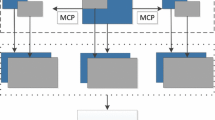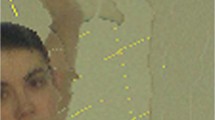Abstract
Depth image based rendering (DIBR), which can generate synthesized images according to the users’ demand, is a key technique for achieving 3D television. However, view synthesis by DIBR technique is very sensitive to depth coding distortion. Because depth distortion will lead to geometrical rendering position errors, and seriously affect the quality of synthesized images. In this paper, we propose an in-loop filter to minimize view synthesis distortion at the cost of transmitting extra filter parameters as supplementary information. And an adaptive parameter determination scheme is presented for the proposed filter. Then a good trade-off between bit rate and view synthesis distortion has been achieved by considering the spatial-temporal correlations of 3D video sequence. The simulation results reveal that the proposed view synthesis distortion elimination method can significantly improve the rate-distortion performance, which achieves Bjontegaard Delta Peak Signal-to-Noise Ratio (BDPSNR) gain from 0.41 to 1.09 dB compared with the benchmark.











Similar content being viewed by others
References
Bjontegaard G (2001) Calculation of Average PSNR Differences between RD-curves, ITU-T Video Coding Experts Group (VCEG), document M33, Austin, TX
Chen Y, Pandit P, Yea S, Lim CS (2009) Draft reference software for MVC, ITU-T JVT –AE207
Domański M, Grajek T, Klimaszewski K, Kurc M, Stankiewicz O, Stankowski J, Wegner K (2009) Poznań multiview video test sequences and camera parameters, ISO/IEC JTC1/SC29/WG11 MPEG 2009/M17050, Xian, China
Feldmann I, Mueller M, Zilly F, Tanger R, Mueller K, Smolic A, Kauff P, Wiegand T (2008) HHI test material for 3D Video, SO/IEC JTC1/SC29/WG11 MPEG2008/M15413, Archamps, France
Hu S, Kwong S, Zhang Y, Kuo C–CJ (2013) Rate-distortion optimized rate control for depth map based 3D video coding. IEEE Trans Image Process 22(2):585–594
Liu S, Lai P, Tian D, Chen CW (2011) New depth coding techniques with utilization of corresponding video. IEEE Trans Broadcast 57(2):551–561
Nagoya University FTV test sequences. [Online]. Available: http://www.tanimoto.nuee.nagoya-u.ac.jp/
Nguyen V, Min D, Do MN (2013) Efficient techniques for depth video compression using weighted mode filtering. IEEE Trans Circ Syst Video Technol 23(2):189–202
Nya PN, Köppel M, Doshkov D, Lakshman H, Merkle P, Müller K, Wiegand T (2011) Depth Image-based rendering with advanced texture synthesis for 3D video. IEEE Trans Multimed 13:453–465
Oh K, Yea S, Vetro A, Ho Y (2009) Depth reconstruction filter and down/up sampling for depth coding in 3-D Video. IEEE Signal Process Lett 16(9):747–750
Oh K, Yea S, Vetro A, Ho Y (2011) Depth coding using a boundary reconstruction filter for 3-D video systems. IEEE Trans Circ Syst Video Technol 21(3):350–358
Tanimoto M, Fujii T, Suzuki K (2009) View Synthesis Algorithm in View Synthesis Reference Software 3.0 (VSRS 3.0), Tech. Rep. Document M16090, ISO/IEC JTC1/SC29/WG11
Tanimoto M, Tehrani MP, Fujii T, Yendo T (2012) FTV for 3-D spatial communication. Proc IEEE 100(4):905–917
Yuan H, Chang Y, Huo J, Yang F, Lu Z (2011) Model-based joint bit allocation between texture videos and depth maps for 3-D video coding. IEEE Trans Circ Syst Video Technol 21(4):485–497
Yuan H, Liu J, Xu H, Li Z, Liu W (2012) Coding distortion elimination of virtual view synthesis for 3D video system: theoretical analyses and implementation. IEEE Trans Broadcast 58(4):558–568
Zhang Y, Jiang G, Yu M, Ho Y (2009) Adaptive multiview video coding scheme based on spatiotemporal correlation analyses. ETRI J 31(2):151–161
Zhang Y, Kwong S, Xu L, Hu S, Jiang G, Kuo C–CJ (2013) Regional bit allocation and rate distortion optimization for multiview depth video coding with view synthesis distortion model. IEEE Trans Image Process 22(9):3497–3512
Zhang L, Tam WJ (2005) Stereoscopic image generation based on depth images for 3DTV. IEEE Trans Broadcast 51(2):191–195
Zhao Y, Zhu C, Chen Z, Yu L (2011) Depth no-synthesis-error model for view synthesis in 3-D video. IEEE Trans Image Process 20(8):2221–2227
Zitnick CL, Kang SB, Uyttendaele M, Winder S, Szeliski R (2004) High-quality video view interpolation using a layered representation. ACM SIGGRAPH and ACM Trans. Graphics 23(3):600–608
Acknowledgments
This work was supported in part by the Natural Science Foundation of China under Grants 61102088 and 61272289, Shenzhen Emerging Industries of the Strategic Basic Research Project under Grant JCYJ20120617151719115, and the Guangdong Nature Science Foundation under Grant S2012010008457.
Author information
Authors and Affiliations
Corresponding author
Rights and permissions
About this article
Cite this article
Zhu, L., Zhang, Y., Wang, X. et al. View synthesis distortion elimination filter for depth video coding in 3D video broadcasting. Multimed Tools Appl 74, 5935–5954 (2015). https://doi.org/10.1007/s11042-014-1898-1
Published:
Issue Date:
DOI: https://doi.org/10.1007/s11042-014-1898-1




